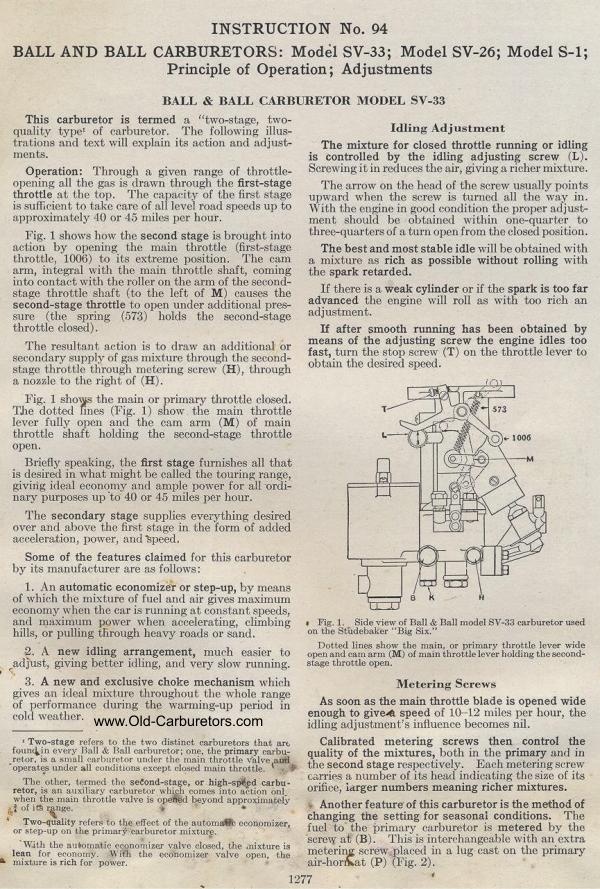BALL AND BALL CARBURETORS: Model SV-33; Model SV-26; Model S-1;
BALL & BALL CARBURETOR MODEL SV-33
This carburetor is termed a "two-stage, two-quality type'
of carburetor. The following illustrations and text will explain
its action and adjustments.
Operation: Through a given range of throttle-opening all the gas
is drawn through the first-stage throttle at the top. The capacity
of the first stage is sufficient to take care of all level road
speeds up to approximately 40 or 45 miles per hour.
Fig. 1 shows how the second stage is brought into action by opening
the main throttle (first-stage throttle, 1006) to its extreme position.
The cam arm, integral with the main throttle shaft, coming into
contact with the roller on the arm of the second-stage throttle
shaft (to the left of M) causes the second-stage throttle to open
under additional pressure (the spring (573) holds the second-stage
throttle closed).
The resultant action is to draw an additional or secondary supply
of gas mixture through the second-stage throttle through metering
screw (H), through a nozzle to the right of (H).
Fig. 1 Amp the main or primary throttle closed. The dotted lines
(Fig. 1) show the main throttle lever fully open and the cam arm
(M) of main throttle shaft holding the second-stage throttle open.
Briefly speaking, the first stage furnishes all that is desired
in what might be called the touring range, giving ideal economy
and ample power for all ordinary purposes up to 40 or 45 miles
per hour.
The secondary stage supplies everything desired over and above
the first stage in the form of added acceleration, power, and speed.
Some of the features claimed for this carburetor by its manufacturer
are as follows:
1. An automatic economizer or step-up, by means of which the mixture
of fuel and air gives maximum economy when the car is running at
constant speeds, and maximum power when accelerating, climbing
hills, or pulling through heavy roads or sand.
2. A new idling arrangement, much easier to adjust, giving better
idling, and very slow running.
3. A new and exclusive choke mechanism which gives an ideal mixture
throughout the whole range of performance during the warming-up
period in cold weather.
= Two-stage refers to the two distinct carburetors that arc foun4in
every Ball & Ball carburetor; one, the primary carbu-
retor, is a small carburetor under the main throttle valve anti-operates
under all conditions except closed main throttle. t i
The other, termed the second-stage, or high-sp4d carburetor, is
an auxiliary carburetor which comes into action onl when the main
throttle valve is opelted beyond approximately of its range.
Two-quality refers to the effect of the automalik economizer, or
step-up on the primary carburetor mixture.
With the automatic economizer valve closed, the mixture is lean
for economy. With the economizer valve open, the mixture is rich
for power.
Idling Adjustment
The mixture for closed throttle running or idling is controlled
by the idling adjusting screw (L). Screwing it in reduces the air,
giving a richer mixture.
The arrow on the head of the screw usually points upward when the
screw is turned all the way in. With the engine in good condition
the proper adjustment should be obtained within one-quarter to
three-quarters of a turn open from the closed position.
The best and most stable idle will be obtained with a mixture as
rich as possible without rolling with the spark retarded.
If there is a weak cylinder or if the spark is too far advanced
the engine will roll as with too rich an adjustment.
If after smooth running has been obtained by means of the adjusting
screw the engine idles too fast, turn the stop screw (T) on the
throttle lever to obtain the desired speed.
Fig. 1. Side view of Ball & Ball model SV-33 carburetor used
on the Studebaker "Big Six."
Dotted lines show the main, or primary throttle lever wide open
and earn arm (M) of main throttle lever holding the second-stage
throttle open.
Metering Screws
As soon as the main throttle blade is opened wide enough to give.ft
speed of 10–12 miles per hour, the idling adjustment's
influence becomes nil.
Calibrated metering screws then control the quality of the mixtures,
both in the primary and in the second stage respectively. Each
metering screw carries a number of its head indicating the size
of its orifice, larger numbers meaning richer mixtures.
. Another feature of this carburetor is the method of changing
the setting for seasonal conditions. The fuel to the primary carburetor
is metered by the screw at (B). This is interchangeable with an
extra meterin screw placed in a lug cast on the primary air-her&at
(P)
Previous page 1927
Supplement Home Next page 
|